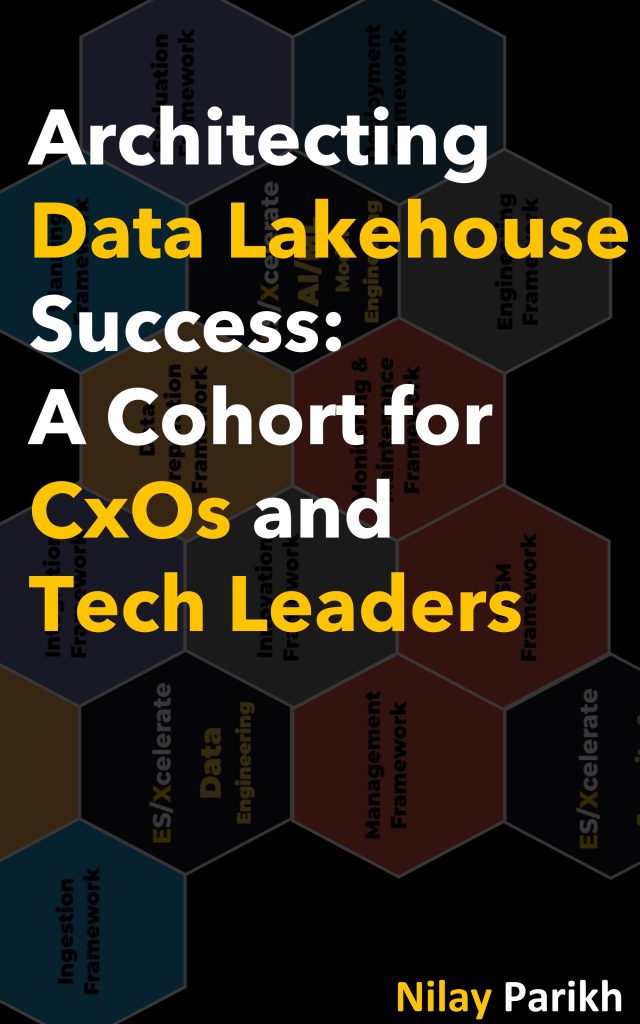
In “Architecting Data Lakehouse Success: A Cohort for CxOs and Tech Leaders,” we embark on an insightful journey through the evolving landscape of data engineering and architecture. This book is a comprehensive exploration, spanning the history, anatomy, and practical application of data lakehouses. It’s designed for technical leaders, architects, and C-suite executives who aim to merge strategic business vision with technical architectural prowess.
Part 1: The Evolution from Data Warehouses to Data Lakehouses
Part 1 traces the evolution of data warehousing from its inception in complex mainframe systems to the modern, more accessible cloud-based data warehouses. It highlights the persistence of core capabilities like structured schemas and SQL querying, alongside the advent of innovations such as machine learning. This part also delves into the rise of Big Data, examining how semi-structured and unstructured data have challenged traditional architectures, paving the way for more agile data lakes. The culmination of this journey is the data lakehouse, a hybrid model combining the reliability of data warehouses with the flexibility of data lakes, underpinned by cloud-native technologies.
Chapter 1: The Rise of Data Warehouses
This chapter charts the evolution of data warehousing from early, complex mainframe systems to contemporary cloud-based solutions. It highlights the persistence of key features like structured schemas, alongside innovations like machine learning, showcasing how data warehouses have adapted to meet evolving business intelligence needs.
Chapter 2: The Era of Big Data and Data Lakes
Exploring the impact of Big Data, this chapter discusses the shift from traditional data warehouses to the more flexible data lakes. It emphasizes the need for balancing governance with agility to harness the full potential of semi-structured and unstructured data without compromising stability.
Chapter 3: Bridging the Gap: The Data Lakehouse Emerges
Focusing on the emergence of data lakehouses, this chapter examines how they combine the best features of data warehouses and lakes. It delves into characteristics like support for batch and streaming data and discusses the rise of cloud-native lakehouses, highlighting their role in fostering innovation and reducing costs.
Part 2: Dissecting the Modern Data Lakehouse
In Part 2, we provide an in-depth analysis of the data lakehouse’s foundational elements and architecture. This section elucidates how a data lakehouse marries the scale and cost-effectiveness of data lakes with the performance and governance of data warehouses. We delve into the three key pillars of this architecture – storage, compute, and orchestration layers – and their interplay in creating a robust, governed data hub. The part also covers metadata’s vital role and the various processing frameworks, offering a comprehensive understanding of the architecture and operation of a modern data lakehouse.
Chapter 4: Foundational Elements of a Data Lakehouse
This chapter dissects the core components of a data lakehouse: storage, compute, and orchestration layers. It discusses how these layers work together to create a scalable, governed data hub, supporting both analytics and data science while maintaining cost-effectiveness.
Chapter 5: Storage Architecture and Data Ingestion
The chapter explores the scalable storage layer of a data lakehouse, including crucial considerations like horizontal scalability and security. It compares various storage formats and delves into data ingestion patterns, emphasizing their roles in optimizing analytics and transactional processing.
Chapter 6: Metadata Management and Data Discovery
Focusing on metadata management, this chapter explains metadata’s multifaceted role in connecting disparate data, ensuring data quality, and upholding security. It highlights how effective metadata management can transform complex data landscapes into coherent and insightful systems.
Chapter 7: Processing Frameworks and Workloads
Here, the various processing frameworks and workloads within data lakehouses are examined. The chapter provides guidance on optimizing batch processing, real-time streaming, and machine learning workloads, discussing governance practices and future-proofing processing architectures.
Part 3: Implementing and Managing Data Lakehouses
The final part focuses on the practical aspects of implementing and managing data lakehouse architectures. It covers crucial topics such as data security, governance, design considerations, technology evaluation, and deployment strategies. This section is invaluable for translating the conceptual understanding of data lakehouses into effective business solutions, providing guidance on everything from security and compliance to choosing the right technology and managing deployment complexities.
“CxO and Architect Alliance: Navigating Data Lakehouse Strategies” is more than just a technical guide; it’s a roadmap for aligning business strategy with technical execution in the realm of data architecture. It aims to foster a synergistic partnership between CxOs and architects, enabling organizations to leverage the transformative power of data lakehouse architecture for innovation and growth.
Chapter 8: Data Security, Governance, and Compliance
This chapter delves into security measures and governance practices crucial for data lakehouses. It covers multifactor authentication, data lineage tools, encryption schemes, and compliance monitoring, emphasizing the intertwined nature of security and governance in data architecture.
Chapter 9: Design Considerations and Process
Detailing the design process of a data lakehouse, this chapter outlines the strategic decisions crucial for aligning technical solutions with business objectives. It covers defining business requirements, assessing data infrastructure, and selecting storage formats to transform data into actionable insights.
Chapter 10: Lakehouse Technology Evaluation
The chapter discusses the evaluation of various technology options for implementing data lakehouses. It compares cloud-managed versus self-managed solutions, major cloud platforms, open-source tools, and commercial solutions, highlighting their respective trade-offs.
Chapter 11: Lakehouse Deployment
Focusing on practical deployment considerations, this chapter provides guidance on navigating the complexities of rolling out a data lakehouse. It covers phased rollouts, user onboarding, and the use of CI/CD pipelines, emphasizing the importance of structured deployment strategies for scalability and impact.
Data Lakehouse Architecture Principles: Consolidated View
The architectural principles within the ES/Xcelerate Data&AI Framework provide a structured foundation for harnessing data and AI in business processes. They encompass modular design for scalability, robust data management for integrity and democratization, and stringent security measures. These principles ensure that data-driven initiatives are efficient, compliant, and strategically aligned with organizational goals, facilitating a seamless transition from data collection to actionable insights.
Data Lakehouse Architecture Risks: Consolidated View
This risk mitigation table offers a comprehensive set of strategies to address a wide array of potential project risks, from technology integration challenges to data security concerns. By following these detailed mitigation approaches, organizations can better prepare for unforeseen obstacles and enhance the success of their projects.
Additionally, the table outlines specific risk areas within data integration and management, offering actionable steps to improve the efficiency, security, and quality of data operations in complex environments. These strategies empower organizations to navigate data-related challenges effectively and maintain a competitive edge in an increasingly data-driven world.
In “Architecting Data Lakehouse Success: A Cohort for CxOs and Tech Leaders,” we present a guide that traverses the evolving landscape of data warehousing and lakehouses. This guide is an essential resource for those seeking to navigate the complexities of architecting and implementing successful data lakehouse solutions in today’s dynamic data-driven environment.
Available at Amazon
- US: https://www.amazon.com/dp/B0CR71D58S
- UK: https://www.amazon.co.uk/dp/B0CR71D58S
- IN: https://www.amazon.in/dp/B0CR71D58S
- DE: https://www.amazon.de/dp/B0CR71D58S
- FR: https://www.amazon.fr/dp/B0CR71D58S
- ES: https://www.amazon.es/dp/B0CR71D58S
- IT: https://www.amazon.it/dp/B0CR71D58S
- NL: https://www.amazon.nl/dp/B0CR71D58S
- JP: https://www.amazon.co.jp/dp/B0CR71D58S
- BR: https://www.amazon.com.br/dp/B0CR71D58S
- CA: https://www.amazon.ca/dp/B0CR71D58S
- MX: https://www.amazon.com.mx/dp/B0CR71D58S
- AU: https://www.amazon.com.au/dp/B0CR71D58S
Disclaimer
The views expressed on this site are personal opinions only and have no affiliation. See full disclaimer, terms & conditions, and privacy policy. No obligations assumed.
